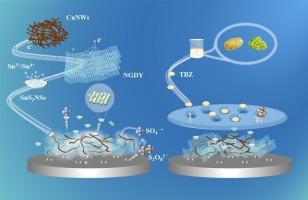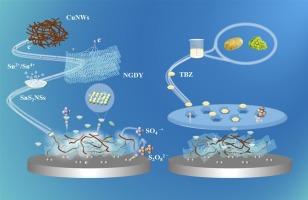基于双单体分子印迹聚合物的内置电位调节和外源激发电化学发光传感器用于噻苯咪唑的生物模拟检测
IF 8.5
1区 农林科学
Q1 CHEMISTRY, APPLIED
引用次数: 0
摘要
食品中的噻苯咪唑(TBZ)残留对公众健康构成严重威胁。本文利用掺氮石墨二乙烯-铜纳米线(NGDY-CuNWs)复合发光体中的电子自调节和二硫化锡纳米片(SnS2NSs)的循环放大策略,开发了一种超灵敏分子印迹电化学发光传感器(MIECLS)来检测TBZ。NGDY-CuNWs 复合发光体是通过自发化学吸附作用形成的,可提供电化学发光信号,其中的电荷再分布产生的内置电势提高了电子转移和氧化还原反应速率。SnS2NSs 上电子对(Sn2+/Sn4+)的循环转化催化了硫酸根阴离子自由基的生成,从而放大了电致发光信号。由于功能单体之间的互补和协同作用,形成了高亲和力的印迹空腔,可识别 TBZ。MIECLS 的检测范围为 1 × 10-9-1 × 10-5 mol L-1,检测限为 1.69 × 10-10 mol L-1,在检测农药残留方面具有巨大的应用潜力。本文章由计算机程序翻译,如有差异,请以英文原文为准。


Built-in potential-regulated and exogenous excited electrochemiluminescence sensor based on dual-monomers molecularly imprinted polymer for the biomimetic detection of thiabendazole
Thiabendazole (TBZ) residues in food pose a serious threat to public health. Herein, an ultrasensitive molecularly imprinted electrochemiluminescence sensor (MIECLS) was developed to detect TBZ, using electron autoregulation in nitrogen-doped graphdiyne‑copper nanowires (NGDY-CuNWs) composite luminophore and cyclic amplification strategy of tin disulfide nanosheets (SnS2NSs). NGDY-CuNWs composite luminophores were formed by spontaneous chemisorption to provide electrochemiluminescence signals, and the charge redistribution in it resulted in a built-in potential that improved the electron transfer and redox reaction rate. The cyclic transformation of electron pairs (Sn2+/Sn4+) on SnS2NSs catalyzed the generation of sulfate anion radicals to amplify electrochemiluminescence signals. Due to the complementary and synergistic interaction of functional monomers, high affinity imprinted cavities were formed to recognize TBZ. MIECLS had a wide detection range of 1 × 10−9–1 × 10−5 mol L−1 with the limit of detection of 1.69 × 10−10 mol L−1 and had huge application potential to detect pesticide residues.
求助全文
通过发布文献求助,成功后即可免费获取论文全文。
去求助
来源期刊

Food Chemistry
工程技术-食品科技
CiteScore
16.30
自引率
10.20%
发文量
3130
审稿时长
122 days
期刊介绍:
Food Chemistry publishes original research papers dealing with the advancement of the chemistry and biochemistry of foods or the analytical methods/ approach used. All papers should focus on the novelty of the research carried out.
 求助内容:
求助内容: 应助结果提醒方式:
应助结果提醒方式:


